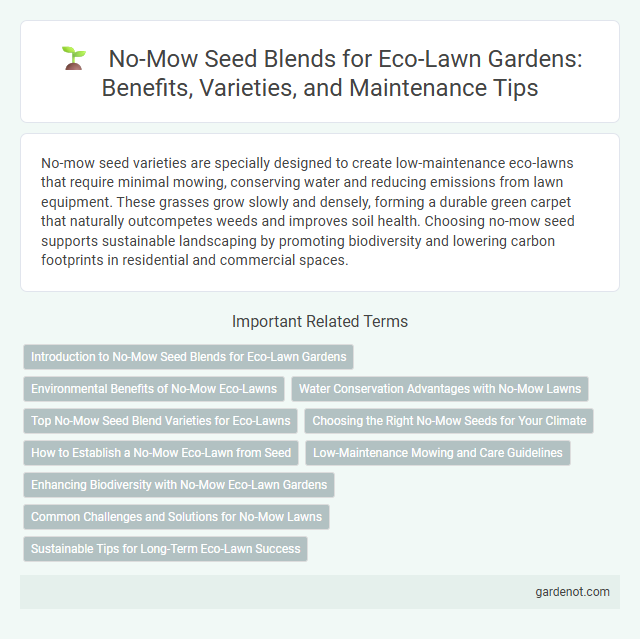No-mow seed varieties are specially designed to create low-maintenance eco-lawns that require minimal mowing, conserving water and reducing emissions from lawn equipment. These grasses grow slowly and densely, forming a durable green carpet that naturally outcompetes weeds and improves soil health. Choosing no-mow seed supports sustainable landscaping by promoting biodiversity and lowering carbon footprints in residential and commercial spaces.
Introduction to No-Mow Seed Blends for Eco-Lawn Gardens
No-mow seed blends for eco-lawn gardens consist of low-growing grasses and clover varieties designed to reduce or eliminate the need for mowing, promoting sustainable yard care and biodiversity. These blends include species like fine fescues and microclovers, which thrive in various soil types while requiring minimal water and fertilizer inputs. By establishing a dense, resilient turf, no-mow seed mixes improve habitat quality for pollinators and decrease lawn maintenance efforts.
Environmental Benefits of No-Mow Eco-Lawns
No-mow seed mixtures promote biodiversity by supporting pollinators and beneficial insects, reducing chemical pesticide use and enhancing local ecosystems. These eco-lawns require less water and eliminate the need for gasoline-powered mower emissions, significantly lowering carbon footprints. Soil health improves through natural aeration and organic matter accumulation, fostering sustainable ground cover that conserves resources.
Water Conservation Advantages with No-Mow Lawns
No-mow seed varieties require significantly less water than traditional grass, promoting optimal water conservation in eco-lawns. Their deep root systems improve soil moisture retention, reducing the need for frequent irrigation and lowering water usage by up to 50%. Choosing no-mow lawns supports sustainable landscaping by conserving local water resources and maintaining healthy ecosystems.
Top No-Mow Seed Blend Varieties for Eco-Lawns
Top no-mow seed blend varieties for eco-lawns include fescue, buffalo grass, and fine-leaf fescues, known for their drought tolerance and low maintenance needs. These blends promote dense, weed-resistant turf that requires minimal watering and no regular mowing, reducing carbon emissions associated with lawn care. Choosing certified organic or native seed mixes ensures healthier soil ecosystems and supports local biodiversity in eco-lawn settings.
Choosing the Right No-Mow Seeds for Your Climate
Selecting the right no-mow seed mix tailored to your specific climate ensures optimal growth, drought resistance, and minimal maintenance. Cool-season seeds like fine fescues thrive in northern regions, while warm-season blends including buffalo grass and Bermuda grass perform better in southern climates. Evaluating soil type and local weather patterns enhances seed adaptation, reducing watering needs and promoting sustainable, eco-friendly lawns.
How to Establish a No-Mow Eco-Lawn from Seed
To establish a no-mow eco-lawn from seed, start by preparing the soil through thorough aeration and removing existing weeds for optimal seed-to-soil contact. Choose a no-mow seed mix designed with drought-tolerant, low-growing grass varieties like fine fescues that require minimal maintenance and mowing. After sowing, maintain consistent moisture levels during germination and avoid foot traffic to ensure healthy root development and a resilient, sustainable lawn.
Low-Maintenance Mowing and Care Guidelines
No-mow seed varieties drastically reduce mowing frequency by growing into dense, low-growing turf that requires minimal trimming, often only once or twice per season. These eco-lawns thrive with simple care guidelines, including planting in well-drained soil, infrequent watering, and avoiding fertilization to promote natural growth. Low-maintenance mowing conserves resources, reduces carbon emissions, and supports biodiversity by allowing native grasses and wildflowers to flourish.
Enhancing Biodiversity with No-Mow Eco-Lawn Gardens
No-mow seed mixtures foster diverse plant species that provide vital habitats for pollinators, birds, and beneficial insects, significantly enhancing local biodiversity. These eco-lawn gardens reduce soil disturbance and chemical usage, promoting healthier ecosystems and sustaining native flora and fauna. By supporting a rich array of wildlife, no-mow eco-lawns contribute to resilient, vibrant urban and suburban green spaces.
Common Challenges and Solutions for No-Mow Lawns
No-mow seed lawns often face challenges such as uneven growth, weed invasion, and slower establishment compared to traditional turfgrass. Solutions include selecting drought-tolerant, native no-mow seed blends with fine fescues or buffalo grass, applying pre-emergent herbicides to control weeds, and moderating watering schedules to promote deep root development. Regular monitoring and localized spot treatments help maintain a healthy, low-maintenance eco-lawn with minimal mowing requirements.
Sustainable Tips for Long-Term Eco-Lawn Success
No-mow seed varieties such as fescues and clover significantly reduce water usage and maintenance, promoting a sustainable eco-lawn. Incorporating organic fertilizers and mulching techniques enhances soil health and supports long-term grass resilience without chemical inputs. Regular aeration and monitoring soil pH ensure optimal nutrient absorption, fostering a durable, environmentally friendly lawn ecosystem.
No-mow seed Infographic

 gardenot.com
gardenot.com